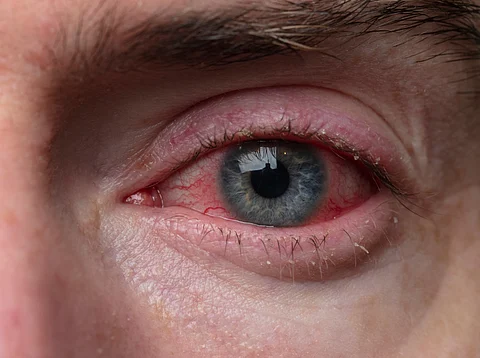Broken blood vessels in the eye are a common condition that transcends age, sex and race. Whether you're young or old, male or female, it can lead to blood appearing in the eye.
What to do when it happens to you?
This article will help you understand when to worry about blood in the eye, and when not to stress. You’ll understand the underlying causes, recognizable symptoms and effective methods to help heal a broken blood vessel in the eye (when possible).
What causes blood in the eye?
“A broken blood vessel and blood in the eye is a common reason that people come to the emergency room, but in most cases, the visit can be avoided,” said Dr. Jim Keany, co-director of the emergency department at Providence Mission Hospital in Orange County, Calif.
“Vessels can break from coughing, aggressive sneezing, rubbing your eye, etc.,” Keany said. “It’s important to understand the difference between a subconjunctival hemorrhage and hyphema. A broken blood vessel in the white part of the eye, called the sclera, is a subconjunctival hemorrhage, and there isn’t anything you can do to get rid of it faster. Think of it as a bruise; you must let it heal.”
“Hyphema, however, is an injury to the clear part of the eye, called the cornea, that may be more serious,” he said. “In this case, the eye might look cloudy or subtly pink. Bleeding in the eyeball itself is very serious, and you need to come to the emergency room for that.”
The Cleveland Clinic explains that hyphema can be caused by anything that hits your eye. Usually, it is a sports injury from a baseball, basketball, softball, soccer ball or paintball. Also, an air bag going off from a car accident can cause this type of trauma.
“Racquetball is another sport that holds serious risk for an eye injury. The size of your eye socket and the size of the racquetball are a concerning similarity, so it is imperative that you wear eye protection when playing,” Keany noted.
Symptoms that may occur with blood in the eye
The Mayo Clinic indicates that a telltale indication of a subconjunctival hemorrhage is a vivid crimson blotch on the white of the eye.
Although it might appear quite bloody, a subconjunctival hemorrhage tends to be less severe than it looks, typically having no impact on your vision and accompanied by no discharge or pain. The only potential discomfort you may experience is a gritty sensation on your eye's surface.
Symptoms of hyphema, however, include:
- Blood inside your eye
- Eye pain
- Blurry or distorted vision
- Light sensitivity
What to do if someone is hit in the eye
The American Academy of Ophthalmology suggests that if someone you are with gets hit in the eye, you do the following:
- Carefully place a cold compress on the eye, to ease discomfort and minimize swelling.
- Avoid employing meat or alternative edible items, as these can introduce bacteria to the eye.
- Refrain from exerting any form of pressure.
- Should a black eye, pain or visual disruption persist following a minor impact, promptly reach out to your ophthalmologist or visit the emergency room. Even seemingly gentle blows can result in substantial eye injuries, such as retinal detachment.
“If someone receives a blow to the eye from a car accident or sports-related injury, the chances are that it will be more serious than a broken blood vessel," Keany said. "In this case, it is best to head to the emergency room to receive prompt medical care.”
How to heal a broken blood vessel in the eye
“When it comes to a broken blood vessel in the eye, there is nothing you can do to help it heal faster,” Keany noted. “I see people in the emergency room all the time asking for my help in making it go away. I’ve had models tell me they have a photo shoot coming up and need to make it heal. But unfortunately, you just need to let it heal on its own.”
The Cleveland Clinic also states that the majority of broken blood vessels typically mend within about two weeks, although more extensive bruising might require additional recovery time. During the blood's gradual disappearance, the affected region's hue might look like a fading bruise.
Should you experience eye discomfort, reach out to your eye care expert.
Prioritize eye protection during sports and exercise patience.
Safeguarding your eyes during sports cannot be emphasized enough. “Utilizing proper eye protection can significantly reduce the risk of enduring a broken blood vessel in the eye. In the event of such an occurrence, remember that healing takes time,” Keany said.
SOURCE: Jim Keany, co-director, emergency department, Providence Mission Hospital, Orange County, Calif.


